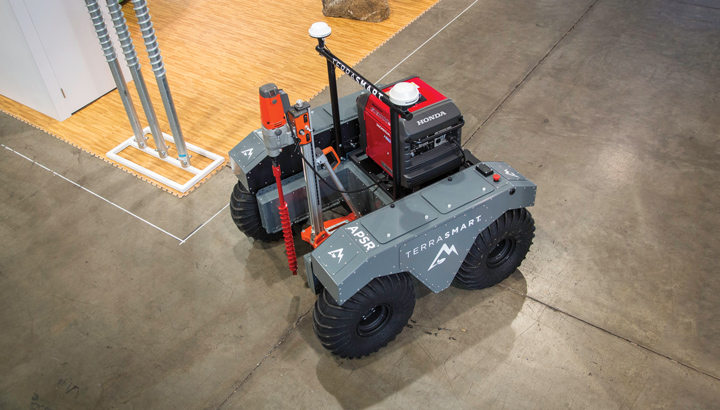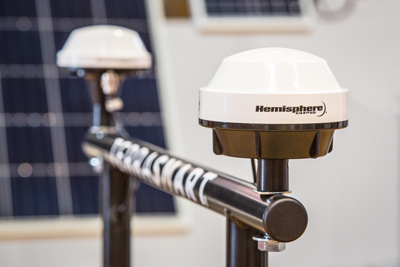Q&A: We get the inside scoop on Terrasmart’s new Robo-Surveyor

Going into 2017, everything you know about solar site surveying has changed, at least according to TerraSmart. Making its debut at the 2016 Solar Power International, TerraSmart’s Autonomous Precision Survey Rover (APSR) does just as the name suggests and automates the surveying process. Soon, a larger model will be able to drill its own holes to set in TerraSmart’s ground screw foundations.
We caught up with TerraSmart President Ryan Reid to learn more.
Solar Builder: This invention seems like witchcraft. Can you explain how it works?
Ryan Reid: The APSR works by using a combination of many proven technologies. We begin with a chassis that was engineered to traverse nearly any terrain in various harsh environmental conditions. We then add key components such as a precision electric/gas hybrid drive system, quad core computer, long range Wi-Fi, safety switches and sensors and various drilling and marking attachments. To give the machine a highly accurate sense of location, we top it off with a pair of high-precision RTK GPS antennas and feed the data into the computer. The operator is then able to use a wireless tablet to upload site information into the APSR’s computer and instruct it to begin work. During its operation, it is giving the operator real-time feedback from its array of sensors as well as information about how much of the job it has completed.
SB: People can be nervous trusting robots to do traditionally human tasks. Can you address these concerns?
Reid: Our goal is not to replace a human with a robot. We are training our existing skilled and talented survey workforce to use better tools such as the APSR that allow them to be safer, more efficient and more accurate. Our first priority was to build a machine that was safe. We’ve done that by using a combination of onboard sensors, physical safety shut off switches belt worn line of sight modules, and advanced routing algorithms.
RELATED: Solar Builder Project of The Year Winner: Moapa Southern Paiute Solar
In terms of reliability, we’ve worked with engineers that have years of experience in rugged robotics design and advanced materials to build a platform that can withstand the rough conditions we face on many of our jobsites today. The accuracy comes from the pair of RTK GPS antennas and high-precision sensors. These are the same antennas being used by traditional human surveyors and therefore have the same accuracy.

The accuracy comes from the pair of RTK GPS antennas
and high-precision sensors.
However, a big challenge of traditional survey is the error that occurs when a surveyor misaligns their range pole. If a range pole isn’t perfectly level/plumb you will not get an accurate survey point. The APSR uses redundant IMU sensors to constantly monitor the level of the machine and make adjustments accordingly.
SB: What are some examples that illustrate the value the ASPR brings to a project in terms of cost and time savings, say, for a 100-MW project?
Reid: The two big benefits of using the APSR are speed and accuracy. The APSR has the capability to cover up to four times the land area as a traditional surveyor. It can accurately survey/stake over 1,300 points in a typical work day as compared to the roughly 200 we see from our traditional survey teams. The software is designed to only survey/stake a point on the ground when all sensors are reporting within tolerance. Therefore if the machine isn’t in the right place, it won’t mark that location until it adjusts its position further. Increased velocity and accuracy can mean reduced cost and time savings on our projects. Our survey can now stay ahead of our foundation teams and eliminate any bottle necks that may have caused in the past. Also, the increased accuracy makes installing our racking products, such as TerraFarm 2, even easier with less field adjustment needed.
SB: Is this just a solution that your team is using, or can it be rented/bought by other
companies?
Reid: TerraSmart is offering the APSR as a service that is part of our turnkey strategy.





